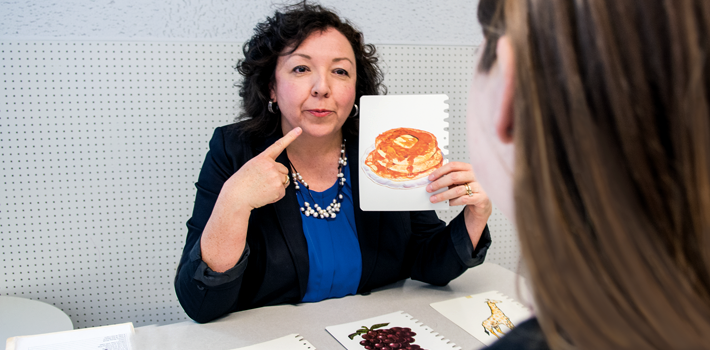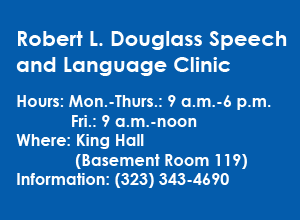Blanca Hatem (’08 M.A.) enrolled in the graduate program for speech-language pathology after her son was treated at the Robert L. Douglass Speech and Language Clinic.
Something to talk about
Speech and Language Clinic serves community while providing one-on-one experience for graduate students
Blanca Hatem attentively listened as her 4-year-old son began counting to ten.
“One, two, three, thor…”
“Four” she corrected him warmly. She thought he sounded adorable getting his sounds mixed up. He continued and tried once more, but time and time again, he could not pronounce the “f” sound.
Hatem began to notice that it was not just with counting. Whenever he spoke he would continually pronounce “th” instead of “f”. Concerned this would become a habit, she asked a few parents at her son’s preschool if they were experiencing the same mispronunciation with their children. That’s when a parent suggested she try speech therapy.
Hatem initially took her son to a private clinic, but concerned with the out-of-pocket costs, she sought a more affordable option. Hatem visited the Speech and Language Clinic at Cal State L.A. and was amazed at the level of care and the progress her son made at the facility.
“We were pleased to find excellent student clinicians who were engaging, energetic, and motivated to do a good job,” she says.
Located in the basement of King Hall, the Robert L. Douglass Speech and Language Clinic has helped countless children and adults with articulation, phonology, language, voice, fluency, and hearing disorders for more than 50 years.
Currently, the clinic treats and evaluates approximately 50 clients per quarter, and provides a great service to the community.
Named for a former professor and department chair who founded the clinic, the facility provides one-on-one services by graduate students supervised by licensed faculty and clinic staff. Clinicians conduct client sessions in a small meeting room while other graduate students observe from a room connected by a one-way mirror.
“This program is definitely the most expensive thing we do as a department since it’s more expensive to run a clinic than it is to teach a class,” says clinic Director Cari Flint. “But student supervision has to be one-on-one, it’s really intense. Two years from now these students will be speech-language pathologists.”
The clinic relies upon word-of-mouth and success stories, like Hatem’s, to attract new clients. Pricing is also an important factor for many clients, as the cost for treatment at the Speech and Language Clinic is significantly lower than private clinics.
“We always try to provide affordable services, and clients are always really happy about that” says Flint.
The clinic’s popularity attracts clients from all over Los Angeles County. With such diversity in client demographics, graduate students learn more about their career responsibilities and how to connect with clients on a personal level.
They share success stories and express how helping the clients has transformed their lives.
Graduate student Susanna Park, for example, recently treated a woman in her early 60s who suffered a stroke. After a lifetime of normal speech, the condition impaired the woman’s ability to use and comprehend words and produce speech. Park worked to help her produce grammatically correct sentences without “filler” words. They made a breakthrough when the client spoke nine words in a row without any fillers.
“She was so motivated and hardworking. I was really excited to be there and share that moment with her,” says Park.
Students are not only inspired by the clients they help, but clients alike are inspired by discovering the growth and improvement that can be achieved one word at a time. The program was so life-changing for Hatem and her son that she decided to enroll in the speech-language pathology graduate program at Cal State L.A.
“Observing my son’s quick progress in correcting his pronunciation errors made me appreciate the value of the profession,” says Hatem, who completed her Master of Arts in Communication Disorders in 2008.
Hatem is currently a speech-language therapist in the Alhambra School District. She says that finding a career in her field was not difficult as the demand for speech-language pathologists is high.
“It was definitely worth it,” Hatem says of the program. “I have a job that I love, have met some of my best friends, and I help students make improvements in their ability to communicate at school, at home, with their friends, and in the community. I feel a tremendous sense of accomplishment from having been successful in Cal State L.A.’s rigorous program. I have knowledge and skills that I will be able to use for the rest of my life and I am passing on my knowledge by mentoring current graduate students.”

